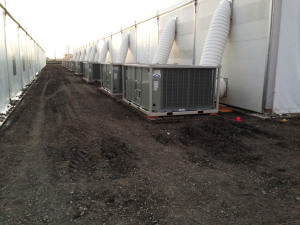When it comes to the oil and gas industry, industrial maintenance, turnarounds and plant expansions are all part of the job. These events enable your operations to continue moving smoothly for years to come.
Over the past few decades, advancements in technology have made fabric structures the ideal solution for petrochemical plant turnarounds, temporary warehouse storage and on-site break areas. As your project needs change or your operations grow, temporary buildings can expand to accommodate additional materials and personnel. These temporary warehouse structures or blast-resistant break tents can be retrofitted with a wide variety of accessories to ensure the comfort of your employees. Plus, the design can help promote a safer, more flexible working environment.
- Temporary warehouses. Whether you’re performing scheduled refinery maintenance or planning an expansion, space is at a premium. It’s crucial to maximize usable space in the turnaround facility for the safety and comfort of your crews. But what do you do with the extra materials? Temporary warehouse structures can be installed on almost any surface — asphalt, concrete or soil — without need of a permanent foundation, which allows you to keep materials close to the job site without cluttering the process area.
- Blast-resistant tents. Risk mitigation and safety precautions are vital not only for the wellbeing of your employees but also as protection for expensive equipment. Until recently, blast-resistant structure options were limited. Size constraints and material limitations made it difficult to place temporary structures close to process units, costing refineries time and money in lost productivity. Newer blast-resistant structures allow your crew to be up to 75 percent closer to process areas, while still offering maximum protection for crews and equipment.
- Amenities. No matter the project, working conditions can be a key factor in deadline setbacks. Employees will be more productive when lunch areas or other facilities are equipped with cooling/heating appliances for their safety and comfort. Fabric structures can be fitted with virtually any amenity, from flooring and lighting to HVAC — and everything in between.
- Fabric structure design. Fabric structures are supported entirely by the outer framework, which offers a unique advantage for refineries. These structures require no columns, which maximizes the interior usable area of a temporary structure and allows large machinery to maneuver more easily.
Another added benefit is the ease with which you can adapt the structure to meet your needs. During extended projects, space needs may change with little to no notice. Fabric buildings can be easily modified to accommodate these changing project specifications at a moment’s notice, saving time and money while meeting the needs of the refinery.

Although temporary in nature, advancements in fabric structure technology are closing the gap between fabric and traditional buildings. These engineered structures meet the code requirements of permanent buildings and can be customized to withstand high winds and snow loads, as well as other extreme weather conditions, making them an ideal solution for refineries, regardless of their location.
When seeking temporary and semi-permanent industrial fabric structures, look for a company with a documented history of innovation and excellence that you can count on to provide safe and compliant tent solutions, no matter how big or small your project’s needs. Such a company should hold ISNetworld, HAZWOPER, TWIC, DISA (Defense Information Systems Agency), PICS (Pacific Industrial Contractor Screening) and OSHA certifications, as well as site-specific credentials, to ensure the safety of its employees and your workforce on-site.
This article originally appeared in BIC Magazine.
